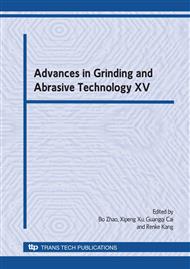p.332
p.337
p.342
p.348
p.354
p.360
p.365
p.370
p.375
An Analyzing on Material Removal Mechanism in Chemical Mechanical Polishing of Cu
Abstract:
The components of material removal in wafer Chemical mechanical polishing (CMP) was described qualitatively based on theory of corrosive wear. The value of each component was obtained by a series of wafer CMP experiments. According to analyzing the experiment results, some conclusions are obtained as follows. There is an optimum polish velocity in wafer CMP at a certain parameter. Under the optimum velocity, the balance of interaction between the mechanical action and the chemical action is reached and the material removal rate approaches maximum. The wafer CMP is a changeful and dynamic process. It cannot be obtained ideal effect of material removal by increasing the mechanical action or chemical action only. The MRR in wafer CMP mainly depends on the interaction result between the mechanical action and the chemical action and the interaction made by abrasives is a decisive part. These results provide a theoretical guide to further understanding the material removal mechanism in wafer CMP.
Info:
Periodical:
Pages:
354-359
Citation:
Online since:
September 2009
Authors:
Price:
Сopyright:
© 2009 Trans Tech Publications Ltd. All Rights Reserved
Share:
Citation:


